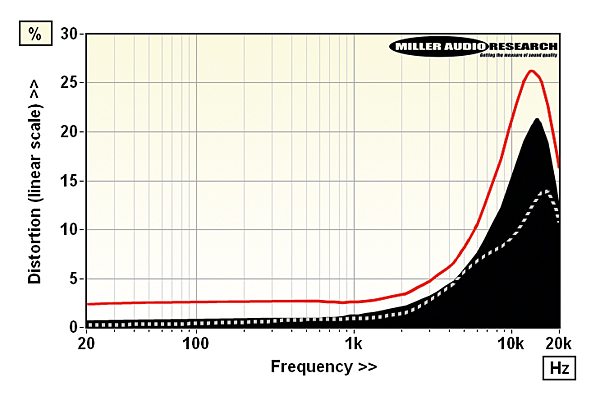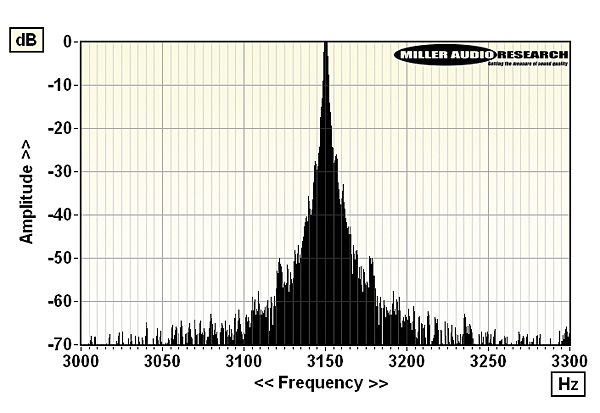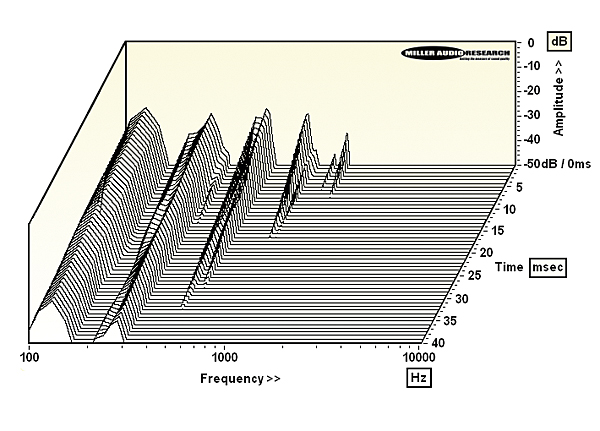VPI Avenger Direct Turntable Package Lab Report
VPI Anniversary Bloodwood
Produced for VPI by Japan's Miyajima Laboratory, the £2550 'Bloodwood' looks a close cousin to the Takumi, sharing the same bonded elliptical stylus and continuous alloy cantilever rather than the alloy-tipped cactus spine that underpins the costlier Saboten model. The Bloodwood also looks to employ Miyajima's cross ring coil structure, for which various claims are made, including reduced distortion, although the unequalised 3.4% (re. 1kHz at 5cm/sec) and lateral/vertical sweeps peaking over 20% (re. –8dB re. 5cm/sec) are higher than average [see Graph 2, below]. Otherwise, output is bang-on the specified 0.22mV at 219µV (re. 1kHz at 5cm/sec) with a fine 0.2dB channel balance from a ~16ohm impedance, requiring a low-noise MC headamp or transformer/MM preamp.
The crimped alloy cantilever and bonded diamond achieve a 26° VTA and while the 2.3g downforce is quite high – and the 16-18cu compliance not especially 'stiff' for a typical MC – the Bloodwood is only a moderate tracker, achieving ~65µm via the right channel before letting go at the penultimate +15dB groove modulation (re. 315Hz/5cm/sec) at ~2 and ~7% THD (left/right). The specific resonances and damping properties of the cantilever and mechanism are revealed in the extended but slightly erratic HF response [Graph 1, below] which shows a broad –2dB mid/presence depression before picking up again at 17-18kHz. The asymmetry revealed between lateral and vertical cuts [solid black vs. red trace, Graph 1] suggests that in-phase/central images (typ. vocals) will enjoy a bolder image than detail at the extremes of the soundstage. Whatever else might be said of VPI's choice of pick-up, it certainly brings a splash of colour! PM


| Generator type/weight | Moving-coil / 8.9g |
| Recommended tracking force | 22-24mN (23mN) |
| Sensitivity/balance (re. 5cm/sec) | 219µV / 0.23dB |
| Compliance (vertical/lateral) | 18cu / 16cu |
| Vertical tracking angle | 26 degrees |
| L/R Tracking ability | 70μm / 65μm |
| L/R Distortion (–8dB, 20Hz-20kHz) | 1.4-18% / 0.8-14% |
| L/R Frequency resp. (20Hz-20kHz) | +0.8 to –4.5dB / +1.0 to –2.5dB |
| Stereo separation (1kHz / 20kHz) | 33dB / 13dB |
VPI Avenger Direct/Fatboy
While Technics may have kick-started a mini 'direct-drive revolution', inspiring both Brinkmann with its Taurus and Bardo, and Thorens with the TD 124 DD [HFN Jul '21], VPI has also adopted a belt-less drive in earlier designs including its HW-40 Anniversary [HFN Apr '19]. The Avenger Direct uses the same 'non-ferrous' motor design with a claimed 2.68Nm/sec torque, bringing the 11kg platter, complete with peripheral ring clamp, up to speed in a little over one second. Absolute speed was an imperceptible +0.03% fast in our sample while peak wow and flutter [Graph 1] is just a little 'tighter' here at 0.02% and 0.03%, respectively, than we saw in the HW-40. Rumble, on the other hand, is about 2dB higher at –71dB through-groove (slightly poorer again at –70dB with the LP weight in place) but far closer to the HW-40 at and –73dB via the motor/bearing itself.
First seen in our review of the HW-40, the partnering 12in Fatboy tonearm features a '3D printed' armtube and integral headshell mounted into a robust gimbal bearing, offering a very low <10mg friction. The lightweight polymer/resin tube material contributes to a moderate 14g effective mass for the arm as a whole, while its variable cross-section (a chamfered square at the bearing to a rounded triangle at the headshell) pushes the first bending mode up to a creditable 130Hz. Harmonic and possible twisting modes appear at 225Hz and 280Hz, followed by more rapidly dissipated modes at 470Hz, 550Hz and 890Hz [see Graph 2, below]. The range of these sharp resonances is not dissimilar to those we've observed from various 'carbon fibre' armtubes, but they are generally better damped by VPI's choice of tube material here. PM


| Turntable speed error at 33.33rpm | 33.34rpm (+0.03%) |
| Time to audible stabilisation | 1-1.5 seconds |
| Peak Wow/Flutter | 0.02% / 0.03% |
| Rumble (silent groove, DIN B wtd) | –71.0dB (–70.2dB with weight) |
| Rumble (through bearing, DIN B wtd) | –72.9dB |
| Hum & Noise (unwtd, rel. to 5cm/sec) | –58.4dB |
| Power Consumption | 5-25W (4W standby) |
| Dimensions (WHD) / Weight | 550x250x425mm / 28kg |
| Price (including arm and cartridge) | £36,500 |


















































